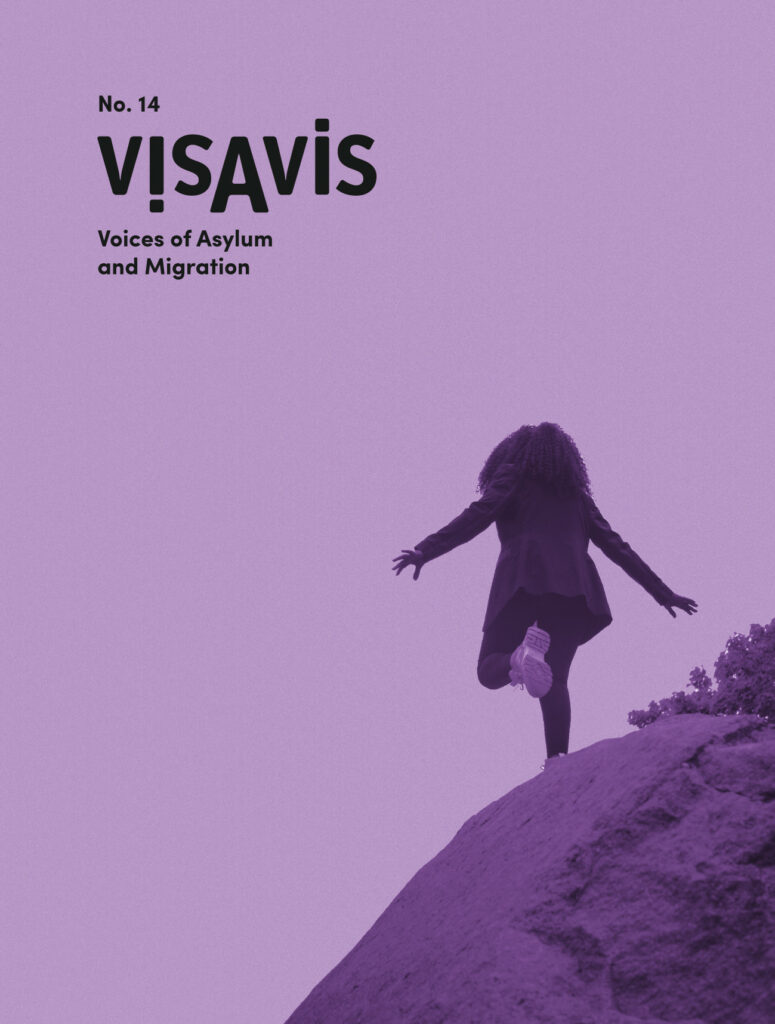Stefan Kruse Jørgensen’s short film The Migrating Image is an investigation of images produced during the so-called European refugee crisis in 2015. It is on view through 6 May as part of Africa: Rethinking Architecture and Design, a group exhibition at the Royal Danish Academy of Fine Arts Schools of Architecture, Design and Conservation in Copenhagen. Through Kruse’s inquiry into the production of images portraying humanitarian affairs, and their most often hidden ideological footing, the film engages in a critique of its own kind.
By Florian Stark
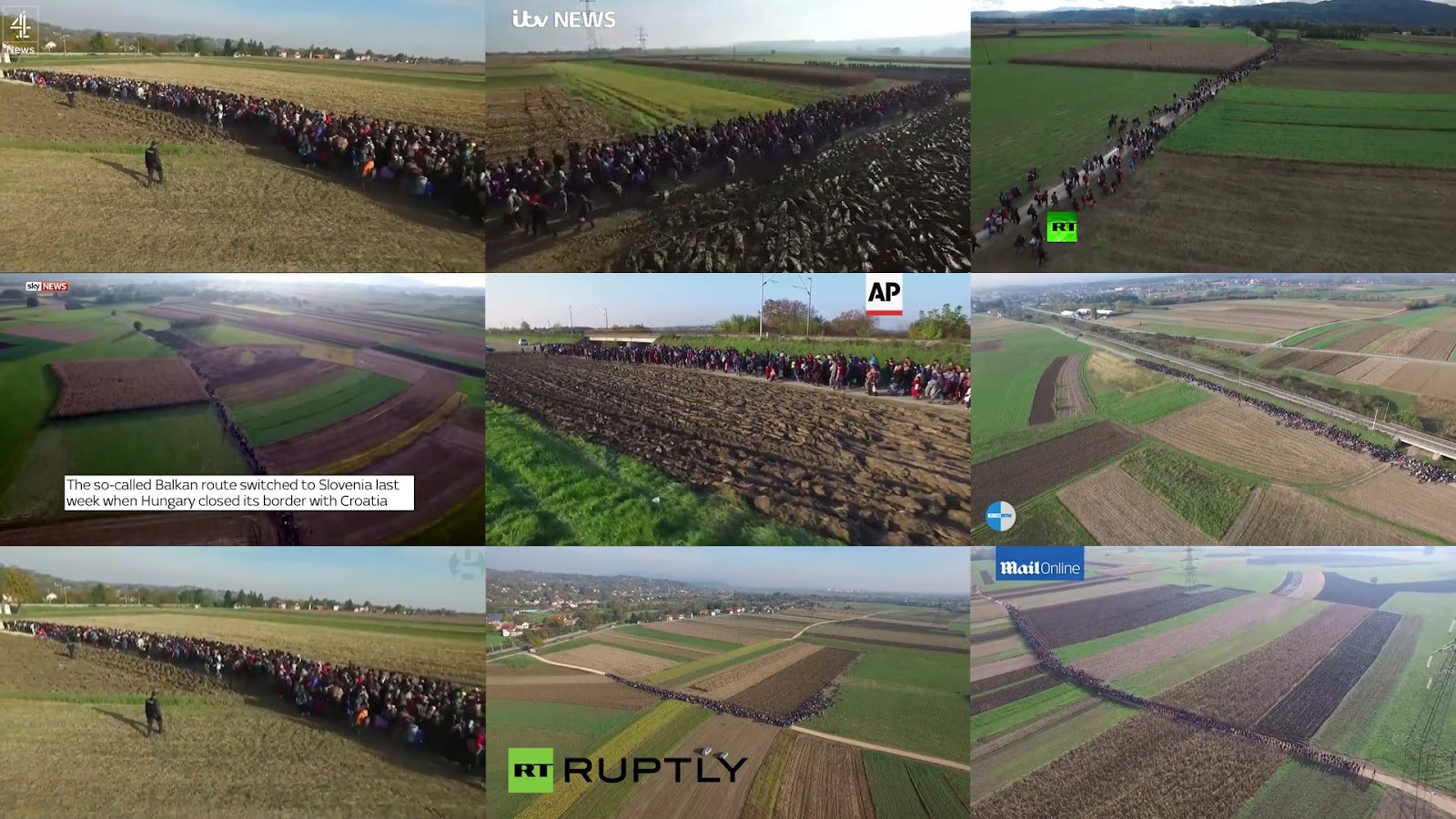
Kept short (28:05), Kruse’s film discusses the production of “technical images” behind the scenes of the crisis. Instead of explaining what caused the movement of approximately one million refugees towards Europe, Kruse directs the viewer’s attention towards a less explored topic: the technicalities behind the images portraying the crisis. Kruse quotes Vilem Flusser, a Czech-born writer, philosopher and journalist, right at the start of the film to contextualize The Migrating Image’s theoretical footing: “Human beings forgot they created images to orientate themselves in the world…. Imagination has turned into hallucination.” Grounded on Flusser’s hallucinating insight, The Migrating Image re-evaluates the images produced and consumed since the summer of 2015, exposing their hidden ideological substructure. In four acts, Kruse presents the techno-analytical perspective of a filmmaker on the production of images that influenced so many public opinions and political decisions.
The Migrating Image’s first act opens with the narrator’s voice telling us: “The production of images begins before the migration takes place.” Kruse’s inquiry begins with a gallery of images posted on Facebook profiles to advertise the services of smugglers and facilitators of flight. The images and profiles Kruse presents are composed of ships, airplanes and passports, as if embarking on the first leads to an obvious attainment of the latter. Additionally, screenshots of Viber messages function as proof of successful arrivals in Italy.
These images and profiles use imagination as a driving force to advocate the decision to travel to Europe, and thereby produce an aura of simplicity regarding access to the continent. The profiles not only aim to show the seemingly easy way to Europe, but also, in many other images, what Europe is really about: French luxury yachts; Italian and German sports cars; lavish apartments; wealth.
The Migrating Image reveals the ironic origins of these images used to sell a path to Europe. Smugglers and other facilitators of flight are compositing images created by European advertising agencies, tourist offices and governments themselves. The images were originally created to export the representation of Europe as a continent of secure jobs, prosperity and security, where highly skilled migrants and experts are welcomed with open arms. However, the images circulate virally and transcend their original purpose of advertising Europe as a Promised Land for businesses and wealthy investors. Images always carry a plurality of meaning; every image has the potential to be rearranged and re-contextualized in a setting where it functions differently. In the case at hand, images exporting a dream of Europe’s wealth are enlisted as promises for the dangerous crossing of the Mediterranean Sea. Yet this export of a superior, imaginary Europe traces right back to European colonialism, which likewise fostered the Eurocentrism of today. The responsibility for the creation and the impact of images we see at the start of Kruse’s film lies not only with the smugglers and facilitators of flight, but is more deeply embedded in Europe’s narcissistic self-conception.
The second act of The Migrating Image takes us onto the Mediterranean Sea itself, where Copernicus views the migrant and refugee boats entering European waters. Copernicus is an Earth-monitoring system that cooperates closely with Frontex, the infamous European Border and Coast Guard Agency. Copernicus translates satellite data into images of red and green dots. These data images are used by Frontex to coordinate its first contact with migrants at sea, which takes the form of soundless recordings made by military helicopters.
The images above were recorded by military cameras in helicopters; they are embellished with additional data such as time, bearing and (in the lower left of the first shot) the pilot’s option to “disarm” the target. Hence, the refugees have become a matter of security. The images recorded by the military are stabilized via a superior image stabilization technique that holds the picture steady on its target, while directed by a manual joystick. These images are officially used by the Italian Coast Guard and Frontex to estimate the number and physical condition of the people in arriving boats. Furthermore, the technological equipment of Frontex allows image production that is not limited to European waters. Exemplifying a process that researcher Martin Lemberg-Pedersen has called “the externalization of European borders,” Frontex maps movements of ships, boats and even trawlers long before they enter European waters. Frontex’s all-seeing eye is continuously expanding, for example through a recent EU agreement with Libya, which allows Frontex to patrol the entire Libyan coast and enhance their image production.
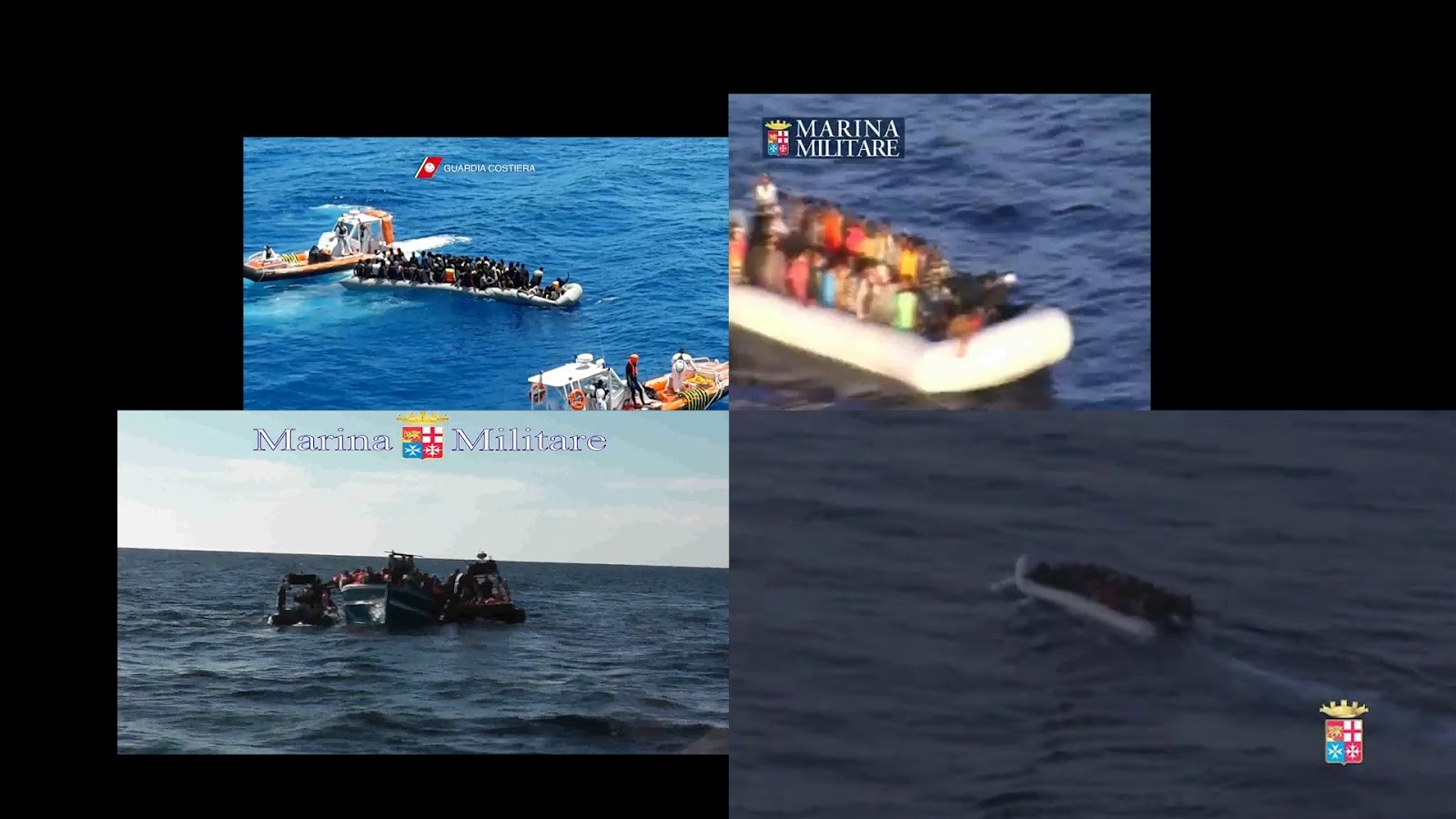
When the silent helicopter images are published, it is beneath the logos of the Italian Navy and Coast Guard. Additionally, GoPro camera shots are added, underlined with piano music and eventually published on the Coast Guard’s YouTube channel with the headline “Angeli di Mare” (“Angels of the Sea”).
The professionality with which those videos are edited and published hint at teams of media specialists accompanying the production of military images. Kruse’s inquiry demonstrates that this is, indeed, the case, by portraying the activities of European Commission Audiovisual Services. This department, connected to Frontex and equal in size to a standard broadcaster, supports the Italian Coast Guard and similar bodies in their imaging of migrant trajectories in the Mediterranean Sea. Some of their images are published for free use online, in print and on television, while others are only available with payment.
The message transmitted by Frontex and the Italian authorities through these images is that their work is crucial for safeguarding European borders from the apparent existential threat posed by undesired migrants – and saving the migrants themselves. The images are contrary to those produced by independent organizations and non-governmental actors which disclose the often-tragic endings of so-called rescue missions operated by Frontex and the Coast Guard. In line with their humanitarian character, the imagery produced by NGOs aims to uncover human rights offences. In any case, rarely do broadcasters make their way onto the Mediterranean Sea to produce their own pictures and images. Therefore, we should be alert and constantly aware that the images European broadcasters edit into their stories of the crisis are coming from a pool of image producers biased in opposing ways.
The Migrating Image displays various images composed to advocate for travel to Europe, to control and monitor movements at sea and to document the work of border security organizations and NGOs. In the third act, Kruse’s inquiry leads us to the production of images by volunteers, refugee support movements and photojournalists alongside the arrival of people at the borders of Europe. In 2015, many European countries birthed massive voluntary pro-refugee movements. At train stations, border crossings and the shores of the Mediterranean, volunteers welcomed (and still welcome) refugees and sought to ease their arrival. As with most life events today, this welcoming is visually documented, saved and shared online. The volunteers, deeply shocked by the conditions of refugees after their long, life-threatening travels at sea, aim to capture and transmit the message of the refugees’ suffering to the rest of the world. However, the first traditionally journalistic production of images starts with the migrants’ contact with photojournalists. In 2015 photojournalists were strongly present where volunteers helped the refugees arriving at the shores, and in camps where migrants were stuck between borders. Kruse offers, in his third act, an intense insight into the work of different photojournalists in the summer of 2015.
Particularly impressive is the capture of a 360-degree camera placed in a warehouse somewhere in the Balkans. Such cameras are by now a well-established tool in digital media journalism, used to advance the immersion of the observer into the moving image. Immersion here refers to the force of an image to mentally engulf the observer. A 360-degree camera is supposed to immerse the viewer, literally, into the central point of the situation where the camera was placed. This particular camera succeeds well in that purpose as it records migrants gathering in front of their lodging, an old warehouse, stuck in between borders – bringing the viewer into the iconic imagery used many times to portray the degree of suffering and misery in which migrants find themselves on the way to Europe.
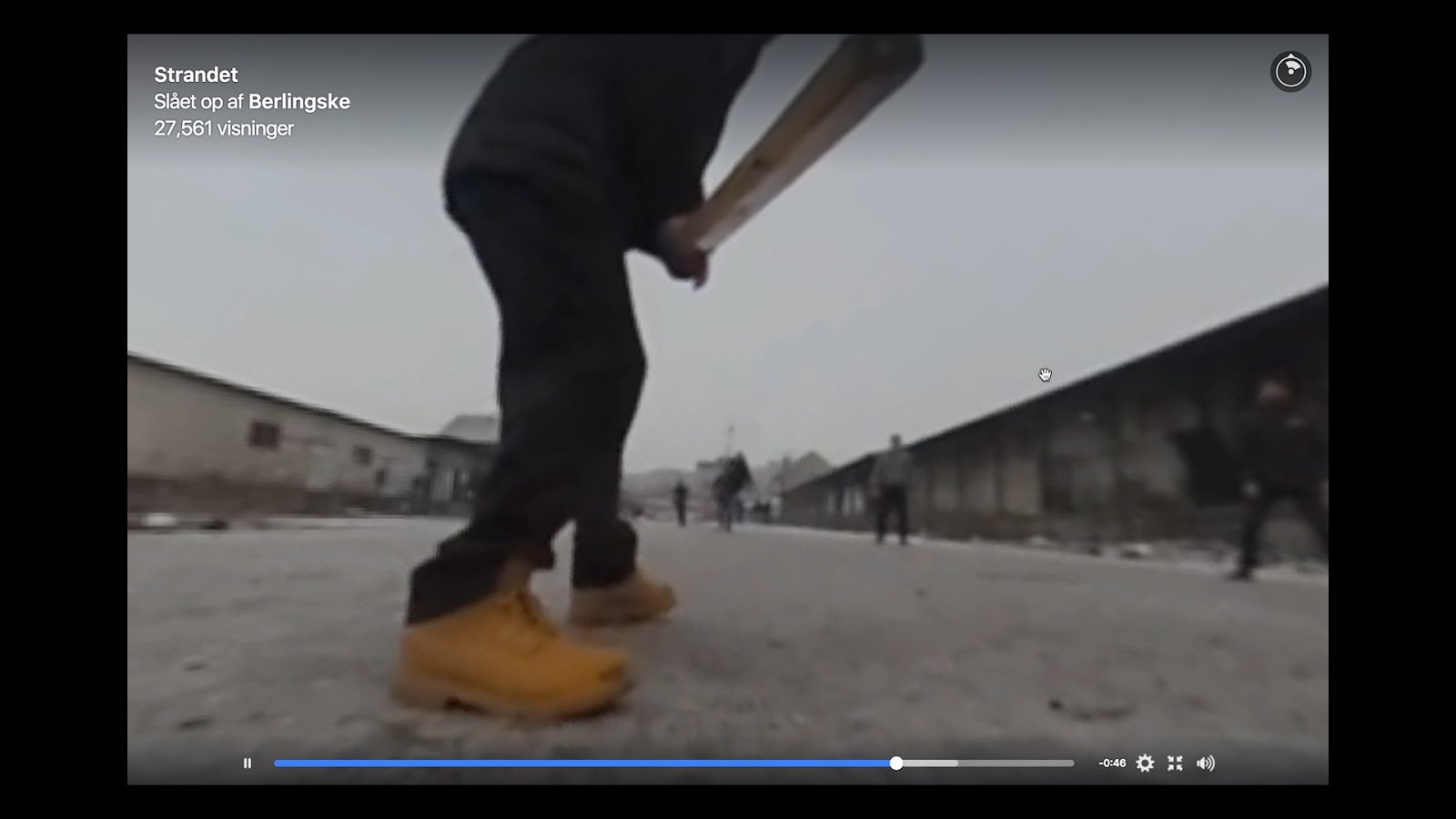
In the fourth and last act, Kruse’s inquiry illustrates another massive image-producing industry and its methods of imaging refugee trajectories as they reached Middle European borders. All at once in 2015, European broadcasters seemed to directly intercept these trajectories. Kruse brilliantly maps out the different methods broadcasters utilized to capture the migrants’ arrival, and focuses on the popular tool of drone footage. For arguably the first time in history, drone shots of arriving people saturated the coverage of outlets such as Russia Today, Daily Mail and Channel 4. The usage of drones is a contemporary strategy for recording large gatherings of people, whether at demonstrations, election parties or football events. What makes drone-shot images so powerful is the ability to grasp the monumentality of large human gatherings, along with the still-novel feeling of seeing the world from above.
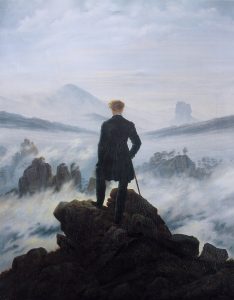
In 1818, such monumental astonishment was famously captured by Caspar David Friedrich’s painting Wanderer above the Sea of Fog. This painting depicts a wanderer looking over the infinite fog covering the world below him. For two hundred years Friedrich’s remarkable painting has evoked feelings of singularity, loneliness and simultaneously attraction. Similar feelings and aura inhabit drone-shot images, as well, and when text and voiceover place these into context, they can quickly turn threatening. Kruse invites us to reconsider the drone shots of large groups of refugees walking between fields towards European borders by placing these one by one next to each other, mapping the proliferation of what began as stock footage captured by three drones on 25 October 2015. One can easily imagine how these images can be perceived differently when headlined and portrayed as “massive crowds” that are “overflowing European borders.” By offering us this perspective on the usage of drone shots when portraying large human movements, Kruse’s work supplies a timely reflection on the drivers of current anti-immigration sentiments in Europe.
Kruse’s short film discusses the danger of images consumed without doubt through its focus on the image production accompanying the “European refugee crisis”. For quite a while now we have witnessed how the production of images can mislead every one of us. Fake news and false information-spread are among our times’ most pressing problems. It can feel as though our eyes and sentiments are lacking the capacity to deflect the reactions that images provoke in our senses. With ever-growing technological progress, media advances in its ability to immerse us in images. Immersion comes with a lack of objectivity, as a strongly immersive image hides its own character as a reproduction of reality, not reality itself. This is the danger of applying advanced media technology to humanitarian issues, where we and others are in danger of being exposed to political despotism. To come back to our starting point, images help us orient in and navigate the world. In his quote Vilem Flusser warns of striving to perfect the image into something ever more “real” – a trap, when it becomes a dangerous production of imagined realities that we fail to reflect on sufficiently.
Kruse’s inquiry comes nearly three years after the events of summer 2015, but the impact of the images he examines can be traced right through current political and societal dynamics. European election campaigns since 2015 have, to a large extent, been built on heated debates over immigration and refugee policies. Right-wing populists have made use of political uncertainties and successfully entered European parliaments, where they currently work to freeze discussions on immigration, openly denying the 1951 Convention Relating to the Status of Refugees and striving to further crack the supranational idea of Europe. The Migrating Image is a small but powerful outline and (re)presentation of some of the images made on both sides of the shores and borders of Europe in 2015. Kruse criticizes, with the help of Flusser, the unreflexive way we perceive images, especially those on deeply humanitarian issues such as flight and refuge. Keeping its own criticism in mind, Kruse’s film is also no more nor less than a subjectively curated, at times vividly arresting collection of images, itself aiming to fit the filmmaker’s narrative. Therefore, a critical but open viewing of The Migrating Image lies in the interest of its own creator.
